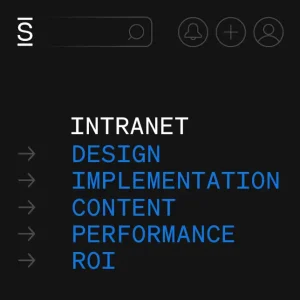People understand the purpose and perhaps the strategy in creating internal comms. However, can you describe how to achieve a return on investment (ROI)? And in three steps? That was the core of the conversation between Simpplr’s Amanda Berry, Corporate Brand & Communications Manager and Head of Internal Communications, and Jason Anthoine, Managing Founder of Audacity, in the ninth Cohesion Podcast.
Audacity describes itself as an internal comms firm, “helping organizations find the courage, confidence, and clarity to kickstart workplace culture.” But that is being quite modest. Audacity is a communications consultancy based in Atlanta, Georgia. They are known for helping establish workplace internal communications, culture building, and improving employee experience through leadership coaching for some of the biggest companies in the world. They also have relationships with smaller businesses.
Their vast clientele gives them knowledge and experience to recognize that companies of all sizes face the same challenges, have similar needs, and have equal opportunities to succeed. But it is not only about tackling problems. It is about having big, hairy, audacious goals. Jason believes that many companies are good at identifying and tackling big, hairy goals. But they weren’t “all that good at the audacious part.”
As for Jason Anthoine, the “Head Honcho,” as he calls himself, he has over 32 years of experience including leading global communications at GE, Newell Brands, and Verint. If anyone understood the importance of internal comms, it would be Jason.
https://player.simplecast.com/2487b144-51eb-45e9-be7c-c350b2034604?dark=false
Finding the Challenges to Solve
There are frequent challenges with internal comms, and, according to Jason, they need to be addressed as soon as you hire employee number two. However, are companies constantly aware of what those challenges are? Businesses may know the underlying issues, but they can’t identify them in detail.
Audacity helps reveal the complications, address them, reorganize your internal comms, and get everyone on board with the change. These usually center on employers’ relationships with employees and the experience they create in the workplace. When asked by Amanda specifically what are the three main common mistakes that companies and businesses make, Jason identified three as his best friends: Human Resources (HR), Internal Communications (IC), and Information Technology (IT). Why are these three at the center of employee scale and experience? Jason stated that it is because those three are most responsible for “all the heavy lifting around culture, employee engagement, employee experience, and all those things.” He also stated that you could fix those issues once you address them. However, he warned that there are three mistakes that companies make in trying to correct these situations.
- Mistake #1:Too Much Volume- More is not necessarily better. Sometimes more is just more. To mitigate their problems around culture and experience, companies put out an excess volume of information. According to Jason, that can lead to a “ton of channels and a ton of content” to reach “everybody wherever it is they are.” The caveat is that though you may be telling employees things they needed to be said, the volume adds to the confusion.
- Mistake #2: Reaching the Right Employee With the Wrong Message- There are various ways to reach your employee base. WebEx to reach teams? Slack? Or should they rely on following digital signage? In an effort to have the broadest reach, your message can be mixed, misconstrued, or lost. Jason believes that regardless of the channels themselves, “what do the folks want from you when you finally do reach them.” The other part of this mistake is that there is a significant challenge in getting leaders to be communicators.
- Mistake #3: Using the Wrong Technology-As Jason said, “There are so many great tools and platforms out there. Not all of them are necessary and needed and certainly not all at once. It’s really hard to get people to these internal comms and HR, and IT teams to understand that less can be more.”
As a customer-focused service business, companies need and want to say many things, but those may not lead them to the goals and outcomes they desire. You need to be audacious, which is where Audacity took its name from.
You need to provide the customer with what they need to succeed. They may not be ready for the answer or want to hear it. According to Jason, “Your job is to help counsel them. Not just take the next order and deliver it.”
Delivering the ROI
Amanda posed a scenario for Jason. She described the dream position for any Internal Comms director. Imagine you are the new Director of Internal Communication, setting up a new function. The CEO says, “We’re prepared to give you anything you need to get this started and moving.” You know that when companies and businesses invest in resources, staff tools, and information technology they need to utilize to succeed, there has to be proof or a show of a return on investment for it all. Where do you begin?
Jason described three steps to set up a course for success and prove ROI.
- Step #1: Breathe- Yes, breathe! A CEO has just questioned you about all the resources, tools, IT software, and human capital you want to be invested in your internal comms. It can be intimidating. So, take a deep breath.
- Step #2: Goals and Outcomes-Get the CEO to give you a copy of their yearly and long-term business plan. This plan shows the CEO and executive teams’ quarterly strategy to accomplish business goals and outcomes. It will explain what they are using to track progress and look at Key Performance Indicators (KPIs). Get your hands on that thing, and learn it inside and out!
- Step #3: Build an internal communications plan that drives all of the business outcomes that the organization is looking for. This process will be easier to measure because all of the comms established are attached to business strategies and outcomes that matter to your company. It is an opportunity for you to manage everything proposed along with whatever your business outcomes are. Since the company is already tracking identified business outcomes on dashboards across the business, the hard work of measuring progress, success, and ROI is already happening. You can easily take those measurements and “backward engineer” them from all the comms you accomplished. Simply draw a direct line between what was done and the results you’re helping to achieve. This motion is not just to show correlation, but causation.
Jason summed it perfectly. He stated that “It’s so important to have your comms strategy built off your business strategy because as good as an internal comms strategy is, it’s telling you and your team what you’re going to do. It’s also your get-out-of-jail-free card for what you are now not going to do. Which is, ‘I’m not going to write your emails for you. I’m going to help you be better at writing them yourself, and then you’re going to be responsible for those.’ Otherwise, your whole team is going to be bogged down with those types of requests, and that’s when you become an arts and crafts department, which is not a strategic business function.”
If you are interested in hearing all the fine details on Jason’s audacious Internal Comms steps for proving ROI, listen to episode on the Cohesion Podcast on Spotify and Apple Podcasts.














